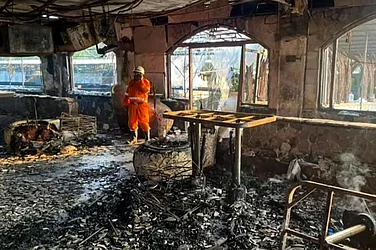The dark stillness of the fields after sunset is broken by the brilliance of fire. On a patch of land, some two kilometres from the highway near Shahbad, a town in the Kurukshetra district of Haryana, a solitary farmer uses his pitchfork to scoop tufts of burning stubble and spread the fire. “I have to burn the field today,” he says. “Tomorrow’s prediction shows rain. I had planned to not burn my field this year and employ labour to remove the stubble, but then came this warning. If the stubble gets wet in rain, I won’t be able to plant wheat next week!” He politely declines to tell us his name. He doesn’t want to get into trouble. They’ve been imposing fines for crop burning.
Although the National Green Tribunal (NGT) order banning crop burning across India came in 2015, the pressure to combat this practice was put on Delhi’s neighbouring states only after pollution in the city reached near apocalyptical proportions in the winter of 2016. Researchers have put a major part of the pollution blame on crop burning.
This year, the Centre allocated Rs 1,151 crore for tackling the problem of crop burning in four states—Punjab, Haryana, UP and Delhi. The sum is to be used for the next two years for making alternative methods of crop residue management work. The aim is to mechanise residue management, especially for paddy, which is harvested in October, so that farmers don’t have to burn it. The Punjab and Haryana governments have used these funds by providing subsidies on specialised farm equipment to farmers.
The strategy looks fine on paper, but putting an abrupt stop to a longstanding practice seems to be an impossible aspiration. The result is that hardpressed for alternatives, farmers in Haryana and Punjab are being penalised for burning their paddy stubble.
“The NGT’s plan had looked reasonable at first. They had done their calculations: the number of machines that would be required to take care of paddy stubble. They had called farmers’ unions to discuss the matter,” says Nek Singh, a farmer from the Nabha district of Punjab and the senior vice president of Bharatiya Kisan Union-Rajewal. “But hardly any equipment has reached farmers in Punjab,” he adds.
Nek Singh has stopped burning stubble since he could afford to spend money on equipment, but he feels those farmers still burning stubble are being pressurised unnecessarily. “Despite the subsidy, the stubble management machines cost a lot. And what’s more, the companies making them increased their rates once the subsidy was announced,” says Nek Singh. Even with the equipment in place, the costs of operation go up for the farmer. “Suppressing stubble through machines costs two, three thousand rupees more per acre.”
Taking into account factors like the rapidly rising diesel prices, the decision to not burn stubble comes with significantly added cost for farmers, many of whom are already debt-ridden. “Let them come and fine, how many will they fine!” says Balvinder Singh of Mandwal village in Patiala district, Punjab, who’s burning his field next to NH 44 in broad daylight. “If we had the resources, we would have not burned our fields. Look around, who wants to do any of this?” he adds. Balvinder echoes the sentiment of many farmers who have to still burn their stubble. And given the added costs that the alternatives carry, the fines—at Rs 2,500 for less than 2.5 acre—are actually a cheaper way out, if at all levied.
On the other end is Surjeet Singh, a big farmer from Sadhugram village in Patiala district. He’s a model farmer who has been using alternative ways of stubble management since 2001. “I started searching for alternatives since 2001, and after many attempts, was successful. You can say that the Happy Seeder was literally invented in my fields” says Surjeet Singh. The Happy Seeder is the main machine which provides an alternative to burning on which the government has given a 50 per cent subsidy to individual farmers. Farmer collectives are being given an 80 per cent subsidy on the same. Surjeet Singh says even he hasn’t received the subsidy amount for his happy seeder yet.
A complete end to crop burning will, of course, require more time and will have to happen organically. Reports suggest that it is on the decline since 2016. According to Punjab agriculture officials, there were 80,879 cases of stubble burning in the state during the paddy season in 2016. This number fell to 43,814 cases in 2017. “We hope to achieve a 100 per cent result in Punjab next year with regard to crop burning,” says K.S. Pannu, agriculture secretary, Punjab. As for the pollution blame from Delhi, he says: “This year crop burning has reduced further, but already, Delhi’s air quality has reached alarming proportions. There is a problem in such diagnoses.” Delhi CM Arvind Kejriwal had tweeted photos of crop burning in Punjab and Haryana on October 20 saying the states did nothing for their farmers and that Delhi would become a gas chamber soon as a result. According to the Central Pollution Control Board (CPCB), Delhi’s air pollution levels for 2017 were also better than they were in 2016. Hence, the cut in crop burning might already be helping. But Delhi’s pollution is a bomb that has exploded only after years of ticking and crop burning is just one of the factors responsible.
Text by Martand Badoni; Photographs: Tribhuvan Tiwari

























